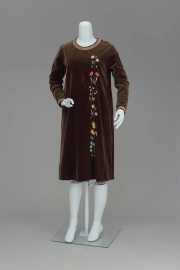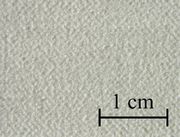Difference between pages "Thulium" and "Velveteen"
(Difference between pages)
Jump to navigation
Jump to search
| Line 1: | Line 1: | ||
| + | [[File:54.620-SC44748.jpg|thumb|Child's dress<br>MFA# 54.620]] | ||
== Description == | == Description == | ||
| − | + | [[File:2000.966-SC58695.jpg|thumb|Square cover<br>MFA# 2000.966]] | |
| − | + | A thick, soft fabric with a dense cut pile on one side. Velveteen is made with a weft pile while [[velvet|velvet]] is made with a warp pile. Velveteen is usually made from [[cotton|cotton]]. | |
== Synonyms and Related Terms == | == Synonyms and Related Terms == | ||
| − | + | velventine (Fr.); velours de coton (Fr.) | |
| − | |||
| − | + | [[File:Image3_802540.jpg|thumb|Bleached Velveteen]] | |
| − | + | ==Resources and Citations== | |
| − | |||
| − | |||
| − | == | ||
| − | |||
| − | |||
| − | + | * P.Tortora, R.Merkel (eds.), ''Fairchild's Dictionary of Textiles'', Fairchild Publications, New York, 1996. | |
| − | |||
| − | |||
| − | |||
| − | |||
| − | |||
| − | |||
| − | |||
| − | |||
| − | |||
| − | |||
| − | |||
| − | |||
| − | |||
| − | |||
| − | |||
| − | |||
| − | |||
| − | |||
| − | |||
| − | |||
| − | |||
| − | * | + | * Rosalie Rosso King, ''Textile Identification, Conservation, and Preservation'', Noyes Publications, Park Ridge, NJ, 1985 |
| − | * | + | * Edward Reich, Carlton J. Siegler, ''Consumer Goods: How to Know and Use Them'', American Book Company, New York City, 1937 |
| − | * | + | * Website: www.fabrics.net |
| − | * | + | * G.S.Brady, ''Materials Handbook'', McGraw-Hill Book Co., New York, 1971 Comment: p. 846 |
| − | * | + | * Wikipedia: http://en.wikipedia.org/wiki/Velveteen (Accessed Nov. 29, 2005) |
| − | * | + | * Art and Architecture Thesaurus Online, https://www.getty.edu/research/tools/vocabulary/aat/, J. Paul Getty Trust, Los Angeles, 2000 |
[[Category:Materials database]] | [[Category:Materials database]] | ||
Latest revision as of 10:51, 25 June 2022
Description
A thick, soft fabric with a dense cut pile on one side. Velveteen is made with a weft pile while Velvet is made with a warp pile. Velveteen is usually made from Cotton.
Synonyms and Related Terms
velventine (Fr.); velours de coton (Fr.)
Resources and Citations
- P.Tortora, R.Merkel (eds.), Fairchild's Dictionary of Textiles, Fairchild Publications, New York, 1996.
- Rosalie Rosso King, Textile Identification, Conservation, and Preservation, Noyes Publications, Park Ridge, NJ, 1985
- Edward Reich, Carlton J. Siegler, Consumer Goods: How to Know and Use Them, American Book Company, New York City, 1937
- Website: www.fabrics.net
- G.S.Brady, Materials Handbook, McGraw-Hill Book Co., New York, 1971 Comment: p. 846
- Wikipedia: http://en.wikipedia.org/wiki/Velveteen (Accessed Nov. 29, 2005)
- Art and Architecture Thesaurus Online, https://www.getty.edu/research/tools/vocabulary/aat/, J. Paul Getty Trust, Los Angeles, 2000


